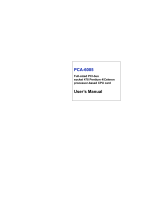l Enable Write Back Cache — Signals the completion of a write request as soon as the data is in cache. Actual writing to the disk occurs at a later time.
The default setting is N/C or Yes.
l BIOS Multiple LUN Support — Provides support for peripherals that contain multiple SCSI devices, such as autoloading tape drives and CD drive
changers.
l Include in BIOS Scan — Enables you to set whether the system BIOS scans this device during system start-up. The default is Yes.
Advanced Configuration Settings
The advanced host adapter settings should not be changed unless absolutely necessary. These values are preset, and changing them may cause conflicts
with the SCSI devices.
l Reset SCSI Bus at IC Initialization — Enables the SCSI bus to be reset when the controller is initialized. The default is Enabled.
l Display <Ctrl><a> Message During BIOS Initialization — Determines whether the Press <CTRL><A> for SCSISelect (TM) Utility! message appears
on your screen during system start-up. The default setting is Enabled. If this setting is disabled, you can still run the SCSISelect utility by pressing
<Ctrl><a> after the host adapter BIOS banner appears.
l Extended BIOS Translation For DOS Drives > 1 GB — Determines whether extended translation is available for SCSI hard drives with capacities
greaterthan1GB.ThedefaultsettingisEnabled.
The standard translation scheme for SCSI host adapters provides a maximum accessible capacity of 1 GB. To support hard drives larger than 1 GB, the
78xx series host adapters include an extended translation scheme that supports hard drives as large as 8 GB, with a maximum partition size of 2 GB
under the MS-DOS®operating system.
It is not necessary for you to enable the Extended BIOS Translation setting if you are using another operating system, such as Novell NetWare.
When you partition a hard drive larger than 1 GB, use the MS-DOS fdisk utility as you normally would. Because the cylinder size increases to 8 MB under
extended translation, the partition size you choose must be a multiple of 8 MB. If you request a size that is not a multiple of 8 MB, fdisk rounds up to the
nearestwholemultipleof8MB.
l Silent/Verbose Mode — Displays the host adapter information during system start-up. The default is Verbose.
l Host Adapter BIOS — Enables or disables the host adapter BIOS. The default setting is Enabled.
If you are booting from a SCSI hard drive connected to the host adapter, the BIOS must be enabled. Disable the host adapter BIOS if the peripherals on
the SCSI bus (for example, CD drives) are all controlled by device drivers and do not need the BIOS.
l Domain Validation — Instructs the host adapter not to accept a negotiated speed until a validation test is successfully performed. After determining the
speed that a target device is capable of, the host adapter sends a Write Buffer command to the target device. The data transfer occurs at the full
speedinitially.Theinitiatorreadsandteststhedataandidentifiesanyparityorcyclicredundancycheck(CRC)errors.Ifthetestfails,theinitiator
lowers its speed and repeats the test. In this manner, a compatible speed will be found and locked in before user data transfers begin. The default is
Enabled.
l Support Removable Disks Under BIOS As Fixed Disks — Controls which removable-media drives are supported by the host adapter BIOS. The default
setting is Boot Only. The following choices are available.
¡ Boot Only — Only the removable-media drive designated as the boot device is treated as a hard drive.
¡ All Disks — All removable-media drives supported by the BIOS are treated as hard drives.
¡ Disabled — No removable-media drives are treated as hard drives. In this situation, software drivers are needed because the drives are not
controlled by the BIOS.
l BIOS Support For Bootable CD-ROM — Determines whether the host adapter BIOS provides support for booting from a CD drive. The default setting is
Enabled.
l BIOS Support For Int 13 Extensions — Determines whether the host adapter BIOS supports disks with more than 1024 cylinders. The default setting is
Enabled.
Using the SCSI Disk Utilities
To access the SCSI disk utilities, select SCSI Disk Utilities from the menu that appears when you start SCSISelect. When the option is selected, SCSISelect
immediately scans the SCSI bus (to determine the devices installed) and displays a list of all SCSI IDs and the device assigned to each ID.
When you select a specific ID and device, a menu appears, displaying the Format Disk and Verify Disk Media options.
l Format Disk — Runs a utility that allows you to perform a low-level format on a hard drive. Most SCSI disk drives are formatted at the factory and do




















